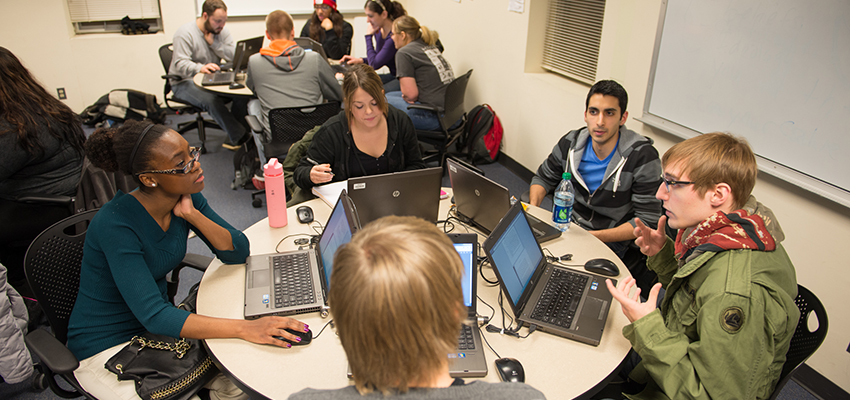Today’s college students are swimming in social media. But that doesn’t make them fish.
Fish don’t have the power to think critically about what they’re swimming in, nor can they get rid of any pollution in the water. The “Net Generation” can broaden their understanding of social media beyond selfies, Snapchat, and status updates, but they need a little help to wade through the muck.
That’s one of the many reasons that Illinois State English Professor Jim Kalmbach chose to focus his next section of Multimodal Composition (ENG 239) this spring on social media. As internship director for the Department of English, Kalmbach has seen the need for a class focusing on social media for students.
“Digital natives tend to know a lot (about social media) on a shallow level, but our job as teachers is to deepen that level,” said Kalmbach, who has studied how college students use social media.
This is the first time the Department of English has offered a class focusing so heavily on social media, but it’s just part of an evolving curriculum at Illinois State that strives to stay current with fast-moving digital life. The School of Communication and Department of Marketing have offered their own courses focusing on, or touching upon, social media for several years.
“We’ve been teaching it for about seven or eight years, but what we teach changes,” said Jeri Beggs, professor of marketing in the College of Business.
In the School of Communication, Assistant Professor of Public Relations Rebecca Hayes said she has incorporated social media into her classroom since 2005.

Illinois State English Professor Jim Kalmbach talks to his students during a recent class at Stevenson Hall.
“I actually started using YouTube the second day it existed,” Hayes said.
It’s all about preparing students for today’s job market.
“My industry uses it extensively,” Hayes added. “We have to use social media with particular target markets, and we have to use it strategically.”
Added Beggs: “It’s just another media vehicle.”
All three professors say one of the major challenges they face in teaching social media is that students do not always realize they need to learn more about it.
“Just using it teaches you to use it with friends,” Hayes said. “The important thing is to learn to use it professionally. Strategies and tactics work for different audiences.”
It’s a distinction that Kalmbach plans to emphasize in his course this semester. After he created the course description, he posted it on Facebook.
“I asked, ‘Am I crazy for doing this?’ And someone posted back, ‘Sounds like you’ll have 23 teachers and one student,’” Kalmbach said. “I’m teaching something that as an activity, most of the students should probably know more about it than I do. I hope that they will be more reflective about why they are doing what they are doing.”
Choosing a textbook
The social media landscape changes quickly—even daily—challenging the traditional approach to college textbooks. Kalmbach, Hayes, and Beggs each have their own approach to course materials.
Kalmbach’s course will include some textbooks that focus on the history and development of social media. Beggs uses trade journals and websites instead, and she insists that articles used throughout the course be published within the last six months to ensure that they are up-to-date. Hayes, on the other hand, uses textbooks as well as social media itself and industry blogs.
Part of Kalmbach’s mission in the course is to have students suggest various social media platforms to use throughout the semester. Each unit of the class will require students to use a different platform, and because the class is “wildly experimental,” he hopes to have a variety, although he knows that he will join Hayes and Beggs in their use of Facebook, Twitter, YouTube, and potentially Pinterest.
“We use the big ones like Facebook and Twitter, but the thing is we need to know what will be big in two years. We need to be using those and be aware of what’s coming next,” Hayes said.
Although each professor brings a different approach to social media, their courses demonstrate the University’s commitment to staying up-to-date with its classes.
“Social media is a part of our lives,” Hayes said.
Grace Johnson can be reached at gvjohns@IllinoisState.edu.

